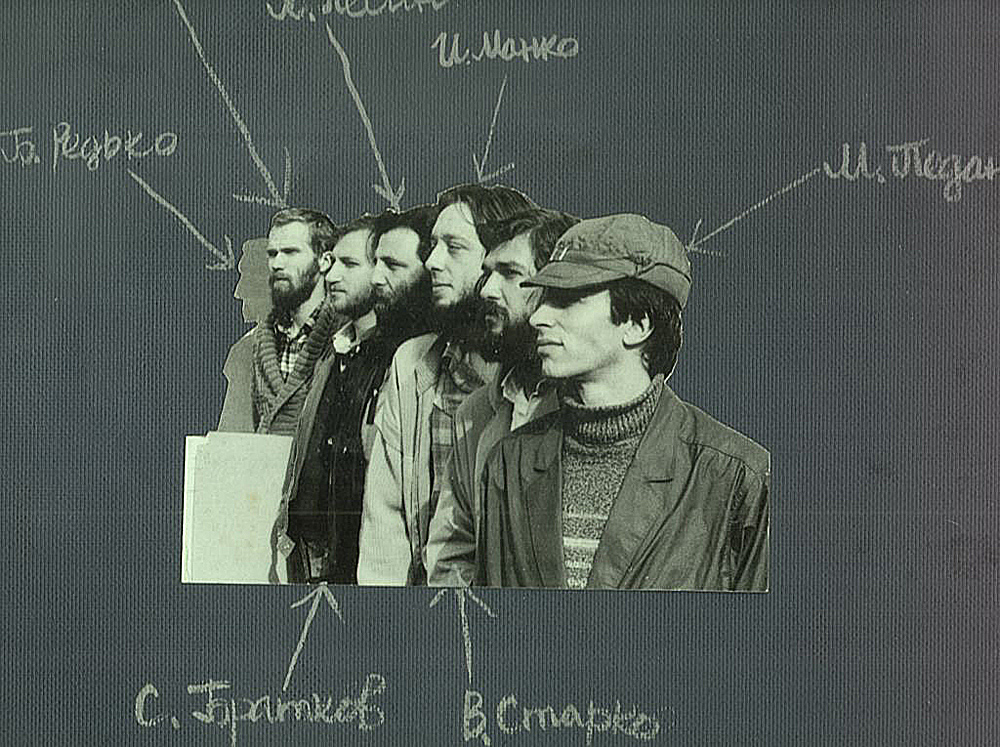The Gosprom Group
 The Gosprom group poster, 1987. Left to right: A silhouette of Boris Redko; Konstantin Melnik, Sergei Bratkov, Leonid Pesin, Igor Manko, Vladimir Starko, Misha Pedan
The Gosprom group poster, 1987. Left to right: A silhouette of Boris Redko; Konstantin Melnik, Sergei Bratkov, Leonid Pesin, Igor Manko, Vladimir Starko, Misha Pedan
About The Gosprom Group:
The Kharkiv art scene in the mid-1980’s felt like a bubble ready to blast. With Gorbachev having announced Perestroika, the totalitarian Soviet state was grudgingly loosening its ideological grip, but the emerging freedom (and the freedom of artistic expression as well) was still a moot concept to be defined.
In 1984 - 1986 a group of younger generation photographers who called themselves the Kontakt Group gathered in Guennadi Maslov’s tiny lab/studio under the roof of one of the so called “Houses of Culture” - Soviet establishments that provided space for various amateur artistic activities of the working class. Ours belonged to the Union of Construction Workers.
We were all producing black and white photographs using closed down aperture when shooting and “point light” when printing images to achieve extra sharpness and depth of field. We were interested in documentary photography and, albeit to different degrees, influenced by our famous predecessors the Vremya group. We felt we needed to join forces to continue and develop the black and white documentary line of our senior colleagues’ artistic endeavor and exhibit as a group. “Nobody really believed that Perestroika would work out, but we all liked that we were allowed to make more noises”, Maslov recalls.
The group had had several exhibitions, when in 1986 Maslov, who was educated as a linguist, got a foreign interpreting assignment and left for Ethiopia to earn money for a decent camera. (He did proudly flash a brand-new Nikon 301 when he returned three years later.) His position and his studio were taken by another group artist Vladimir Starko.
Meanwhile, the artistic activity in the city was gaining momentum. Numerous shows opened, sometimes in most inappropriate spaces like gymnasiums, cafes, theater foyers and stairwells. Starko curated an exhibition of painting and photography on the premises of our Construction Worker’s House of Culture, and was immediately fired for exhibiting West-influenced formalist art, alien to Soviet people. (It was the first show for Sergei Solonsky whose portfolio is part of this project.)
The group lost its artistic refuge, but intensified its activity. In 1987 the group artist Misha Pedan got a job at the Students’ Palace, another Soviet “big style” invention. The same year the first grand-scale exhibition of Kharkiv photography (both the Vremya group and the younger artists), organized by Pedan, attracted crowds of spectators lining up to enter a large space (a disco floor) of the Palace. The next day a friendly deputy director of the Palace secretly informed Pedan that the exhibition, which violated a whole bunch of Soviet taboos, was about to be closed down by the KGB. The art community resisted those attempts. A public discussion was initiated, which salvaged the show for 10 days and further arose the interest of visitors. The exhibition saw an unprecedented attendance of about 2000 visitors daily.
It was after the success of that period that the group artists could deservedly consider themselves part of the Kharkiv School of Photography. The group also acquired a new member artist Sergei Bratkov who was to become internationally recognized in the 2000’s. Now we wanted a new name to reflect the progress, and, after a discussion initiated by Misha Pedan and Leonid Pesin, the group was renamed.
The Gosprom (abbreviated from “state industry”) Building is the only internationally known landmark of the city of Kharkiv. Built at the turn of the 1920’s - 1930’s when Kharkiv was the capital of the Soviet Ukraine, using a cutting edge liquid concrete technology, it is an architectural monument to Soviet Constructivism that can be found in the books on the history of world architecture. It has always been the city symbol and, as such, it rooted the group into the Soviet past and linked it with the Kharkiv photography present and future - or, so was our perception of the name and of our role in the Kharkiv School at the time. Sergei Bratkov produced his The Gosprom series to commemorate the event.
In 1988 another “grand” exhibition at the Students’ Palace lived for only 4 days before being closed by the Communist Party officials, which resulted in Pedan’s loosing his job. Misha Pedan tells the story.
The Gosprom group stayed active on the Kharkiv art scene for several more years, exhibiting their work both locally and internationally.
The beginning of the 1990’s, economically and artistically a most challenging time in Soviet and post-Soviet history, saw the group’s slow, but inevitable disintegration. Some members of the group continued to photograph, some moved to the West, some chose other careers.
The artists associated with the Gosprom group and their 1990’s careers:
(Linked below is to each artist page)
Sergei Bratkov - ran the Up/Down Gallery in the 1990’s, then moved to Moscow, where he teaches at the Rodchenko School.
Konstantin Melnik - abandoned photography by the mid-1990’s. (His work isn’t available for this project.)
Igor Manko - suspended his artistic activity in 1994 - 2004 to manage a language school.
Guennadi Maslov - moved to the US in 1993. Photographer and professor of
Photography at University of Cincinnati, Blue Ash.
Misha Pedan - moved to Sweden in the early 1990’s. Teaches at the Stockholm School of Photography.
Leonid Pesin - moved to Australia in the late 1990’s.
Boris Redko - abandoned photography by the mid-1990’s and switched to painting.
Vladimir Starko - abandoned photography by the mid-1990’s.
We welcome your comments. VASA Exhibitions are the result of various curators, artist, and photographers.